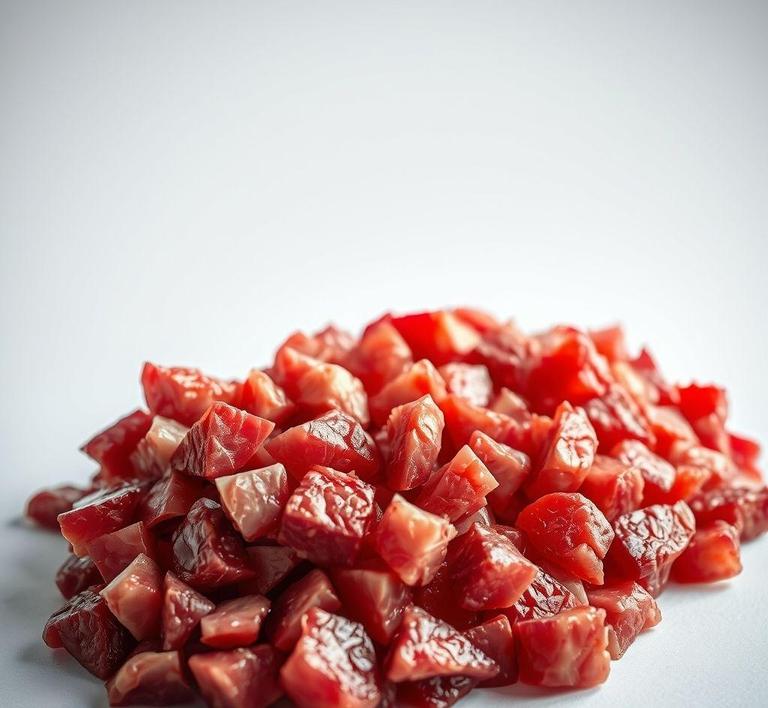Refreezing chop meat can be a bit tricky, but with the right know-how, it’s totally doable! Many people wonder if it’s safe to refreeze meat after it’s been thawed, and the answer is yes, but only under certain conditions. If you’ve thawed your chop meat in the fridge and haven’t let it sit out too long, you can refreeze it without compromising too much on taste or texture. However, it’s important to make sure the meat hasn’t been sitting out at room temperature for more than two hours. This guide will walk you through the best practices for refreezing chop meat, so you can safely store leftovers or buy in bulk without worrying about waste!
Can You Refreeze Chop Meat?

Refreezing chop meat (ground beef or minced meat) is a topic that often sparks confusion and concern in the kitchen. After all, it’s not uncommon for people to find themselves with leftover meat after a meal prep session or a last-minute change of dinner plans. So, the burning question remains: Can you refreeze chop meat?
The short answer is yes, you can refreeze chop meat, but it requires some careful consideration. Understanding the science behind freezing, thawing, and refreezing is important to ensure you maintain both the safety and quality of the meat. Freezing essentially halts bacterial growth by lowering the temperature to a level that bacteria can’t thrive in, but once the meat is thawed, its microbial activity resumes. Refreezing, if done improperly, can cause bacteria to grow to unsafe levels, which is why there are certain steps you need to follow.
The USDA advises that raw meat, including ground meat, can be refrozen if it was thawed in the refrigerator and hasn’t been out of the fridge for more than a couple of hours. However, there are some important nuances when it comes to refreezing raw versus cooked chop meat. Refreezing cooked chop meat is much safer, as it has already undergone the cooking process, which kills any potentially harmful bacteria that may have been present.
The concern with refreezing raw meat is the growth of bacteria during the thawing process. If you thaw meat at room temperature or leave it in unsafe conditions for an extended period, bacteria will proliferate rapidly, making the refreezing process risky. To ensure the meat is safe, you must thaw it in the refrigerator, not on the countertop, and it should be refrozen within a few days. If the meat has been thawed for longer than this, it’s generally not recommended to refreeze it.
How To Refreeze Chop Meat?
If you’ve decided to refreeze your chop meat, the key is in doing it correctly to minimize any health risks and preserve the quality of the meat. Here’s a step-by-step guide on how to refreeze chop meat safely and efficiently:
1. Ensure Proper Thawing
- Refrigerator Thawing: The safest way to thaw chop meat is in the refrigerator. This allows it to thaw gradually while staying within a safe temperature zone (below 40°F). Never leave meat to thaw at room temperature or in hot water, as this accelerates bacterial growth.
- Thawing Time: Depending on the amount of meat, this process can take several hours to a day. If you’re short on time, you can also thaw meat in the microwave or use the cold-water method, but these require immediate cooking to ensure food safety.
2. Check For Signs Of Spoilage
Before you even think about refreezing the meat, check for any signs that it has gone bad. Look for an off smell, a slimy texture, or discoloration. If the meat shows any of these signs, it’s better to discard it than risk illness.
3. Separate Into Smaller Portions
If you’ve thawed a large quantity of chop meat, consider dividing it into smaller portions before refreezing. Smaller portions will freeze and thaw more evenly, reducing the risk of bacterial growth and making it easier to defrost only what you need in the future.
4. Packaging
Proper packaging is crucial in preventing freezer burn and maintaining quality. Use airtight packaging, such as vacuum-sealed bags or plastic wrap followed by aluminum foil. If you don’t have a vacuum sealer, heavy-duty freezer bags work just fine, but make sure to remove as much air as possible before sealing the bag.
5. Label And Date
Always label your meat packages with the date so that you know how long it’s been in the freezer. While chop meat can stay frozen for a while, ideally, you want to use it within three to four months for the best quality.
6. Refreeze Immediately
Once the meat is properly packaged, place it in the freezer immediately. Don’t let it sit around outside of the fridge or freezer for too long, as this can lead to further bacterial growth.
7. Only Refreeze Once
Ideally, meat should only be refrozen once. If you’ve already thawed and refrozen it once, it’s best to use it within a few days. If you’re in doubt about its safety, it’s better to cook it up before refreezing, or simply use it within the next day or two to avoid unnecessary risks.
Quality Impact
Refreezing chop meat doesn’t come without its consequences, especially regarding quality. While it may still be safe to eat if handled correctly, the texture and taste can deteriorate each time it goes through a freeze-thaw cycle.
Texture And Moisture Loss
When meat is frozen, the water inside it forms ice crystals. As these ice crystals expand, they can rupture the muscle fibers in the meat. While thawing, the moisture that was once trapped in these fibers leaks out, leaving the meat drier and less tender. When you refreeze chop meat, the damage compounds, leading to an even greater loss of moisture. The result is often a tougher, chewier texture that may be less pleasant to eat.
Freezer Burn
If meat isn’t properly sealed or if it’s left in the freezer for an extended period, freezer burn can occur. Freezer burn happens when the meat is exposed to air in the freezer, causing dehydration and oxidation. This results in off-flavors and a dry, tough texture. Freezer burn isn’t harmful, but it does negatively affect taste and texture. The longer you freeze chop meat, the more noticeable these changes will be.
Flavor Changes
The more times you freeze and thaw meat, the more it loses its fresh flavor. This is partly due to the breakdown of fats during the freezing process, which can cause the meat to develop an off-flavor. For chop meat, which is often used in dishes like burgers or tacos, this loss of flavor can be more noticeable.
Refreezing chop meat is technically safe if done properly, but there are several considerations to keep in mind. The most important factor is ensuring that the meat is thawed in a safe manner (preferably in the fridge) and refrozen quickly to avoid any bacterial growth. However, it’s important to understand that the quality of the meat will degrade with each freeze-thaw cycle. The texture will become tougher, moisture will be lost, and freezer burn can damage the meat if not properly sealed.
The best practice is to avoid refreezing raw chop meat unless absolutely necessary. If you find yourself with leftovers, try to use them within a few days or cook the meat and freeze it in its cooked state to preserve both safety and quality. Lastly, always check for signs of spoilage before refreezing, and label your meat so you can keep track of its storage time. With these precautions in place, you can safely refreeze chop meat without sacrificing too much on quality, but for the best experience, consider using freshly thawed meat for your next dish.
Is It Safe To Refreeze Chop Meat?
Refreezing chop meat is a topic that often generates confusion and concern, but it can be done safely under the right conditions. When raw chop meat, or ground meat, is thawed, the potential for bacterial growth increases, which is why it’s critical to handle it with care. However, if done properly, refreezing can still be safe and effective.
The key point to remember is that the meat should not be left at room temperature for extended periods. According to food safety experts, chop meat should not sit out for longer than two hours at room temperature (or one hour if the temperature exceeds 90°F or 32°C). Thawing meat in the fridge is the safest method, and it ensures that the meat remains at a temperature where bacteria cannot thrive.
If you thawed your chop meat in the fridge and it’s still fresh (not sitting at room temperature for too long), you can safely refreeze it within a short time. However, this process does come with caveats. The texture and flavor of the chop meat may suffer slightly upon refreezing because of the breakdown of the meat’s structure, but as long as it’s cooked thoroughly upon thawing, it will generally be safe to eat.
One thing to note: the repeated freezing and thawing cycle can reduce the meat’s quality. It may dry out and lose some of its juiciness. That’s why if you plan to refreeze it, it’s better to do so soon after thawing, preferably within 1-2 days, rather than keeping it for extended periods.
Signs That Chop Meat Should Not Be Refrozen
While refreezing chop meat can be safe, there are definite signs to look for that indicate it should not be refrozen. These signs often point to improper handling or spoilage and can lead to serious food safety risks if ignored.
- Off or Sour Odor: Fresh chop meat should have a neutral, slightly metallic odor. If it has a sour or ammonia-like smell, it’s a sign of bacterial growth and spoilage. In such cases, the meat should be discarded immediately.
- Discoloration: Fresh chop meat is typically pink or red in color. If the meat has turned brown or grayish, it could indicate that it has started to spoil, even if it hasn’t been thawed for long. While slight color changes can occur during freezing, a noticeable shift in color often signals that refreezing isn’t safe.
- Slimy Texture: Meat that feels slimy or sticky to the touch is a sign of bacterial contamination. The slime is often a result of the breakdown of the meat’s proteins, making it unsafe for consumption. If the chop meat has this texture, it should not be refrozen.
- Excessive Liquid: If there’s a pool of liquid surrounding the thawed chop meat, it’s likely a sign of degradation, and the meat is past its prime. While some liquid is normal during the thawing process, an overwhelming amount is a red flag that the meat may have started to break down.
- Freezer Burn: If the meat shows signs of freezer burn, such as dry patches or ice crystals on the surface, while not necessarily harmful, it can affect the taste and texture of the meat. It’s safe to eat but may not yield the best results if refrozen.
Common Refreezing Mistakes
Refreezing meat comes with a number of potential pitfalls that could lead to unsafe practices or a diminished product. Here are some common mistakes to avoid:
- Thawing Meat at Room Temperature: One of the most significant mistakes people make is thawing chop meat on the counter. When meat is left at room temperature, it enters the danger zone for bacterial growth, which typically ranges from 40°F to 140°F (4°C to 60°C). Instead, always thaw meat in the fridge, where it can stay at a safe temperature.
- Refreezing Meat Multiple Times: Each time meat is frozen and thawed, it loses moisture and begins to deteriorate in quality. Refreezing meat multiple times leads to an accumulation of this moisture loss and degradation, making the meat dry, tough, and unappetizing. Try to limit refreezing to only once, ideally as soon as possible after thawing.
- Improper Packaging: Not using airtight packaging or failing to remove excess air can result in freezer burn or contamination from other foods. Always ensure that chop meat is tightly wrapped or sealed in vacuum-sealed bags to preserve its quality during freezing and refreezing.
- Not Cooking Meat Before Refreezing: While refreezing raw chop meat is technically safe if handled properly, it’s often better to cook it before refreezing. Cooking the meat before freezing helps to kill any bacteria and ensures that the meat will be safe to eat upon reheating, especially if it’s going to be refrozen and thawed again.
- Waiting Too Long to Refreeze: Waiting too long to refreeze meat after it’s been thawed can put you at risk of bacterial contamination. As a general rule, try to refreeze within 1-2 days of thawing if the meat has been kept in the fridge.
Tips And Tricks
- Use Proper Storage Containers: Invest in quality freezer bags or airtight containers specifically designed for freezing meat. If using freezer bags, press out as much air as possible to prevent freezer burn. You can also consider using a vacuum sealer for longer storage periods.
- Label Your Meat: Always label and date your meat before freezing. This way, you’ll know how long it has been in the freezer, and you can plan to use it within a safe timeframe (typically within 3-4 months for optimal quality).
- Thaw Meat in the Refrigerator: If you’re planning to refreeze meat, always thaw it in the fridge. This minimizes the risk of bacteria growth, ensuring that when you cook it, it’s safe for consumption.
- Cook Before Refreezing: If you’re unsure whether you’ll be able to use your meat before it spoils, cook it first. Cooked chop meat can often withstand the freezing and refreezing process better than raw meat, retaining more flavor and moisture after reheating.
- Keep Freezer Temperature Consistent: Ensure your freezer maintains a consistent temperature of 0°F (-18°C) or lower. If your freezer temperature fluctuates, the meat could thaw and refreeze intermittently, which could increase the risk of bacterial growth.
Conclusion
Refreezing chop meat can be done safely if proper precautions are taken, but it requires careful handling and attention to detail. While it’s safe to refreeze meat that has been thawed in the fridge, it’s crucial to pay attention to signs of spoilage such as bad odor, discoloration, slimy texture, or freezer burn. These are red flags indicating that the meat is no longer safe to refreeze.
To avoid common mistakes like thawing at room temperature, improper packaging, or refreezing multiple times, always store your chop meat in airtight containers, keep the freezer temperature steady, and try to cook it before refreezing whenever possible.
In the end, while refreezing chop meat can be convenient, it’s best used with a bit of caution. When handled properly, you can safely extend the shelf life of your meat, though the quality may not be the same as when it was first frozen. Always prioritize safety and quality to ensure your meals remain both delicious and safe to consume.


